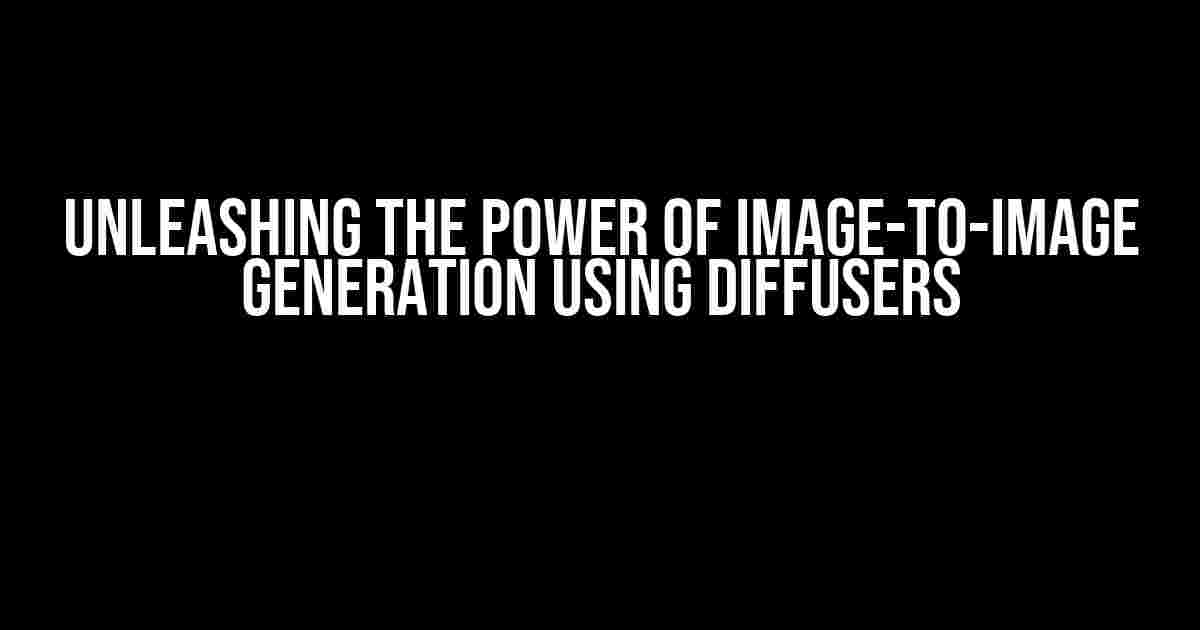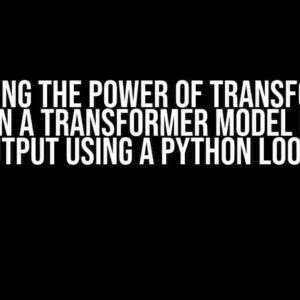Are you tired of manually editing images to achieve a specific style or effect? Do you want to explore the infinite possibilities of image-to-image generation? Look no further! In this comprehensive guide, we’ll delve into the world of diffusers and show you how to harness their power to create stunning image transformations.
What are Diffusers?
Diffusers are a type of neural network architecture that has revolutionized the field of image-to-image generation. They work by learning a probabilistic distribution of the input data and then sampling from that distribution to generate new, realistic images. In simple terms, diffusers can take an input image and transform it into a new image that meets a specific condition or style.
Why Use Diffusers for Image-to-Image Generation?
- Flexibility: Diffusers can be trained on various datasets and tasks, making them incredibly versatile.
- Realism: Diffusers generate highly realistic images that are often indistinguishable from real-world images.
- Efficiency: Diffusers can process images at an incredible speed, making them ideal for real-time applications.
- Customizability: Diffusers can be fine-tuned to meet specific requirements, allowing for unparalleled control over the generation process.
Setting Up Your Environment
Before we dive into the world of diffusers, make sure you have the following installed:
- Python 3.7 or later
- PyTorch 1.9 or later
- Transformers 4.10 or later
- Datasets (e.g., PyTorch Datasets or Hugging Face Datasets)
Additionally, we’ll be using the popular diffusers library, which provides a unified interface for various diffuser models. You can install it using pip:
pip install diffusersLoading and Preprocessing Data
For this example, we’ll be using the celeba dataset, a popular dataset for image-to-image generation tasks. First, let’s load the dataset:
import torch
from torch.utils.data import Dataset, DataLoader
from torchvision import datasets, transforms
celeba_dataset = datasets.CelebA(root='.', split='train', download=True, transform=transforms.ToTensor())Next, we’ll create a custom dataset class to preprocess our data:
class CelebADataset(Dataset):
def __init__(self, celeba_dataset, image_size):
self.celeba_dataset = celeba_dataset
self.image_size = image_size
def __getitem__(self, index):
image, _ = self.celeba_dataset[index]
image = transforms.functional.resize(image, self.image_size)
return image
def __len__(self):
return len(self.celeba_dataset)Training a Diffuser Model
Now that our data is loaded and preprocessed, let’s train a diffuser model using the diffusers library:
from diffusers import DiffusionModel, Trainer
# Initialize the diffuser model
model = DiffusionModel(image_size=256, num_steps=1000, channels=3)
# Create a data loader for our dataset
batch_size = 32
data_loader = DataLoader(CelebADataset(celeba_dataset, image_size=256), batch_size=batch_size, shuffle=True)
# Train the model
trainer = Trainer(model, data_loader, num_epochs=10, learning_rate=0.001)
trainer.train()Generating Images with Diffusers
With our trained model, we can now generate stunning images using diffusers!
Using the Trained Model for Image-to-Image Generation
# Load a sample image
sample_image = celeba_dataset[0][0]
# Create a condition vector for the desired output
condition_vector = torch.randn(1, 128) # For example, a random vector with 128 dimensions
# Generate an image using the trained model
generated_image = model.generate(sample_image, condition_vector)
# Display the generated image
import matplotlib.pyplot as plt
plt.imshow(generated_image.permute(1, 2, 0).detach().numpy())
plt.show()Tips and Tricks for Image-to-Image Generation
- Experiment with different condition vectors: Try generating images with different condition vectors to see how they affect the output.
- Adjust hyperparameters: Fine-tune the model’s hyperparameters to achieve better results.
- Use different datasets: Experiment with various datasets to explore the capabilities of diffusers.
- Combine diffusers with other techniques: Explore the possibilities of combining diffusers with other image processing techniques.
Conclusion
In this comprehensive guide, we’ve explored the world of image-to-image generation using diffusers. By mastering the power of diffusers, you can unlock new possibilities for creative image manipulation and generation. Remember to experiment, fine-tune, and push the boundaries of what’s possible!
| Diffuser Model | Description |
|---|---|
| DDPM | Denoising Diffusion Probabilistic Model |
| DDIM | Denoising Diffusion Implicit Model |
| ADM | Analytic Denoising Model |
For more information on diffusers and image-to-image generation, be sure to check out the following resources:
- Diffusion-based image synthesis with score-based models
- Denoising diffusion-based image synthesis
- Diffusers GitHub Repository
Happy generating!
Note: This article is intended for educational purposes only and should not be used for commercial or malicious activities.
Frequently Asked Questions
Get ready to unleash your creative genius with image-to-image generators using defusers! But before you dive in, let’s tackle some frequently asked questions.
What is an image-to-image generator, and how does it use defusers?
An image-to-image generator is an AI-powered tool that transforms one image into another based on a set of instructions or conditions. Defusers, in this context, refer to the neural network architecture that helps refine and improve the generated images. By leveraging defusers, image-to-image generators can produce more realistic and detailed outputs.
What kind of inputs can I use with an image-to-image generator?
The possibilities are endless! You can use a wide range of inputs, such as photographs, sketches, drawings, or even 3D models. The generator will then use this input to produce a new image based on the defined conditions. For example, you could use a daytime photo as input and generate a nighttime version of the same scene.
Can I use image-to-image generators for commercial purposes?
Absolutely! Image-to-image generators have numerous commercial applications, such as generating product images, creating personalized content, or even developing virtual try-on features for e-commerce platforms. However, be sure to check the licensing agreements and usage rights for the specific generator you’re using to ensure you’re complying with the terms.
How does the defuser architecture improve the generated images?
The defuser architecture plays a crucial role in refining the generated images by reducing noise, removing artifacts, and enhancing overall quality. By iteratively applying the defuser, the generator can correct mistakes, fill in gaps, and create more realistic and coherent outputs. This results in images that are often indistinguishable from real photographs.
Can I train my own image-to-image generator using defusers?
Yes, you can! With the right tools and expertise, you can train your own custom image-to-image generator using defusers. This requires a significant amount of data, computational power, and knowledge of deep learning architectures. However, the payoff can be tremendous, as you’ll have a tailored generator that meets your specific needs and requirements.


